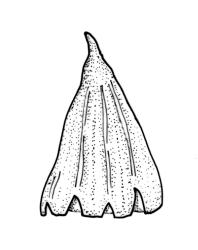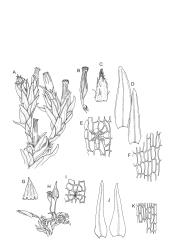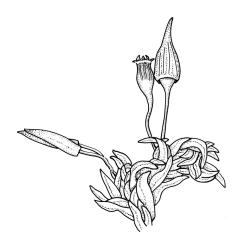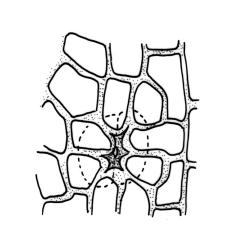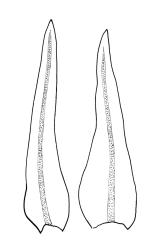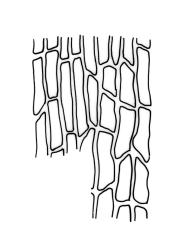- = Orthotrichum avonense R.Br.bis, Trans. & Proc. New Zealand Inst. 27: 438 (1895)
- = Orthotrichum minimifolium R.Br.bis, Trans. & Proc. New Zealand Inst. 27: 439 (1895)
- = Orthotrichum minutum R.Br.bis, Trans. & Proc. New Zealand Inst. 27: 437 (1895)
- = Orthotrichum calvum var. brevisetum Dixon, Bull. New Zealand Inst. 3: 173 (1926)
Plants in dense rounded tufts, yellow-green to pale olive-green above, grey-green to brown below. Stems branched by innovation, 4–15 mm, with well-developed, smooth and brown rhizoids below. Leaves contorted and twisted when dry, spreading when moist, narrow lanceolate to ovate-lanceolate, broadly acute to obtuse at apex, entire, plane or slightly recurved in middle, 1.6–2.3 × 0.5–0.6 mm; mid and upper laminal cells ± isodiametric, rounded or angular, with thin to fairly thick walls, unistratose, 7–11 × 7–10 µm, with 1–2 low, unbranched papillae per cell; basal laminal cells rectangular to rhomboidal, thin-walled, scarcely nodose, yellow or orange, 17–34 × 6–10 µm; with several rows at margins short, rectangular, and with moderately thickened transverse walls. Costa as per genus. Gemmae absent.
Gonioautoicous. Perichaetial leaves not differentiated; vaginula strongly hairy. Perigonia as per genus. Setae elongate, c. 2.0–4 mm, usually c. 1.5 mm exposed beyond the perichaetial leaves; capsules exserted, rarely emergent only, cylindric-urceolate, pale yellow-brown, with 8 deep furrows reaching from the mouth almost to the base and somewhat constricted below the mouth when dry, weakly furrowed when moist, mostly single; exothecial cells differentiated into 8 bands of 3–5 thick-walled cells and bands of thinner-walled cells (corresponding with the furrows); stomata immersed, almost completely covered by the subsidiary cells, restricted to the lower half of capsule; operculum as per genus. Peristome double; exostome teeth 8, orange near the base and grading to almost hyaline at apex, strongly recurved when dry, evenly papillose; preperistome absent; endostome segments 8 (sometimes 16), narrow and usually uniseriate, hyaline, smooth or papillose. Calyptra campanulate-mitrate, constricted at the base when young, mostly yellow to copper but red-brown at apex and sometimes at base, sharply 8-plicate, mostly naked, rarely with a few hairs. Spores globose, isosporous and 1-celled, 20–24 µm.
Although O. calvum is a variable species it is easily distinguished from the other cryptopore species of Orthotrichum. The contorted and twisted dry leaves and the configuration of the leaf cells, in particular its short rectangular basal marginal cells with thickened transverse walls, and its nearly naked calyptra, set it apart from other cryptopore species in the genus.
Its contorted and twisted dry leaves give this species, even in the field, a Ulota-like appearance. Orthotrichum calvum can be distinguished macroscopically from Ulota by its naked or nearly naked calyptra. Also, under the microscope, its immersed stomata scattered through much of the urn readily differentiate it from Ulota, in which the stomata are superficial and restricted to the neck and lower portion of the urn.
NI: N Auckland (Te Paki), S Auckland, Gisborne, Hawke’s Bay, Taranaki, Wellington; SI: Nelson, Marlborough, Canterbury, Westland (Kellys Creek, Franz Josef, Wanganui River, Haast River), Otago, Southland; St. Lewinsky (1984) characterised the N.Z. distribution of this species as "common in the North Island southwards from 38°S, more scattered in the South and Stewart Islands" and provided a detailed distribution map showing a concentration of records in southern Otago and eastern Southland. A collection from Te Paki (N Auckland L.D.; P. de Lange 10199, AK 330986) extends the range considerably north of the distribution documented by Lewinsky.
Endemic.
Epiphytic on a diverse range of plants, and occasionally epilithic on non-calcareous rock. Lewinsky’s comment (1984, p. 443) that it tolerates a warmer climate than its congeners in N.Z. is confusing. While O. calvum (together with O. tasmanicum) appears to be the most commonly recorded species in relatively low rainfall areas of Hawke’s Bay L.D., it is also commonly collected in Taranaki and recorded from Westland L.D. (Lewinsky 1984, fig. 37). She described it as "locally abundant" in some wetter parts of the country. Documented by Lewinsky (1984, tab. 1) on 22 genera of native and introduced woody plants. Occurring from near sea level (Wanganui River, Nelson L.D.) to at least 670 m elevation (at Hopuruahine Stream, Gisborne L.D.). Lewinsky (1984, p. 443) suggested that it may occur to c. 1000 m elevation.
Lewinsky indicated that O. calvum is unusual among the Australasian species for having a chromosome number of n = 6 and immersed stomata; the combination of these features obscures its relations within the genus.



